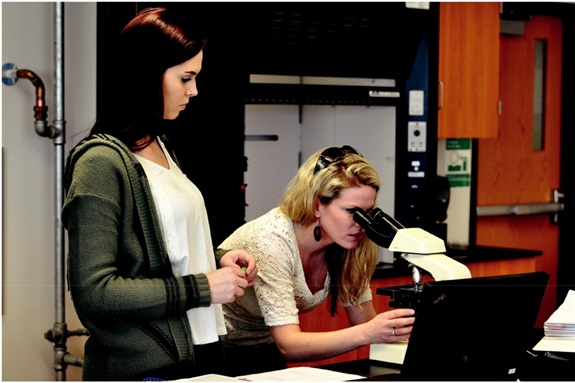Overview

Associate of Science (AS)
The Associate of Science degree is designed for students planning to transfer credits to a baccalaureate degree program at a four-year institution within Oregon public universities. It allows for more freedom in course section that the AAOT/ASOT, but does not guarantee that students will be accepted as having completed all lower division comprehensive and general education requirements for a baccalaureate degree.
Unless otherwise noted;
- Complete all courses with a minimum grade of "C" or "Pass" or better. Students must have a cumulative GPA of 2.0 at the time the AS is awarded.
- Courses may not be double counted within General Education (e.g. Oral Communication and Arts and Letters)
- General Education courses must include;
- Writing (8CR): WR 121 and either WR 122 or WR 227
- Oral Communication (3CR+): COMM 111 or COMM 112
- Math (4CR+): MTH 105 or higher
- Health/PE: HE250 + 1 CR in PE or HE/PE295 (max 3 CR): HE295, HE 242, HE 250, HE 254, PE 295, PE 142, PE 182
- Information Literacy: embedded within WR courses
- Arts & Letters/Humanities: two courses (6 credits) for AS degrees (e.g. ART, COMM, ENG, MUS, REL, PHL or Foreign Language)
- Social Science: two courses (6 credits) for AS degrees (e.g. PSY, SOC, PS, HST, or ECON)
- Science/Math/Computer Science: 7 credits for AS degrees with at least one lab science (e.g. MTH, CS, BI, G, GS, GEO, CHEM, PHY).
- A Maximum of 12 credits can be Career Technical Education courses
- A Maximum of 9 credits can be from courses labeled 199/299
- A Maximum of 24 credits can be ESOL
- A Maximum of 24 credits can be "P" grades
- A Maximum of 21 credits can be from Credit for Prior Learning (CPL)
- Electives must be used to bring the program of study up to a minimum of 90 credits, and a maximum of 108
- 30 credits are required to meet residency at TBCC, 24 of which must apply to the degree for which the student is being awarded
Program Learning Outcomes
Meets General Education Requirements
In addition to Institutional Learning Outcomes, standards have been established for Student Learning Outcomes in General Education Courses in the following categories: Arts and Letters, Cultural Literacy, Mathematics, Science or Computer Science, Social Science, Speech and Oral Communication, Writing, and Information Literacy. Coursework in each of these areas supports student achievement of these outcomes. TBCC evaluates student achievement of course learning outcomes on a regular basis, and this information is used for continuous improvement in instruction and student services.
Arts & Letters
Outcomes
As a result of taking General Education Arts & Letters* courses, a student should be able to:
- Interpret and engage in the Arts & Letters, making use of the creative process to enrich the quality of life; and
- Critically analyze values and ethics within a range of human experience and expression to engage more fully in local and global issues.
- *“Arts & Letters” refers to works of art, whether written, crafted, designed, or performed and documents of historical or cultural significance.
Cultural Literacy
Cultural Literacy outcomes will be included in courses that meet the outcomes and criteria of an AAOT Discipline Studies requirement.
Outcomes
As a result of taking a designated Cultural Literacy course, a student should be able to:
- Identify and analyze complex practices, values, and beliefs and the culturally and historically defined meanings of difference.
Mathematics
Outcomes
As a result of taking General Education Mathematics courses, a student should be able to:
- Use appropriate mathematics to solve problems; and
- Recognize which mathematical concepts are applicable to a scenario, apply appropriate mathematics and technology in its analysis, and then accurately interpret, validate, and communicate the results.
Science or Computer Science
Outcomes
As a result of taking General Education Science or Computer Science courses, a student should be able to:
- Gather, comprehend, and communicate scientific and technical information in order to explore ideas, models, and solutions and generate further questions;
- Apply scientific and technical modes of inquiry, individually, and collaboratively, to critically evaluate existing or alternative explanations, solve problems, and make evidence-based decisions in an ethical manner; and
- Assess the strengths and weaknesses of scientific studies and critically examine the influence of scientific and technical knowledge on human society and the environment.
Social Science
Outcomes
As a result of taking General Education Social Science courses, a student should be able to:
- Apply analytical skills to social phenomena in order to understand human behavior; and
- Apply knowledge and experience to foster personal growth and better appreciate the diverse social world in which we live.
Speech/Oral Communication
Outcomes
As a result of taking General Education Speech/Oral Communication courses, a student should be able to:
- Engage in ethical communication processes that accomplish goals;
- Respond to the needs of diverse audiences and contexts; and
- Build and manage relationships.
Writing
Outcomes
As a result of completing the General Education Writing sequence, a student should be able to:
- Read actively, think critically, and write purposefully and capable for academic and, in some cases, professional audiences;
- Locate, evaluate, and ethically utilize information to communicate effectively; and
- Demonstrate appropriate reasoning in response to complex issues.
Information Literacy
Information Literacy outcomes and criteria will be embedded in the Writing Foundational Requirements courses.
Outcomes
As a result of taking General Education Writing courses infused with Information Literacy, a student who successfully completes should be able to:
- Formulate a problem statement;
- Determine the nature and extent of the information needed to address the problem;
- Access relevant information effectively and efficiently;
- Evaluate information and its source critically; and
- Understand many of the economic, legal, and social issues surrounding the use of information